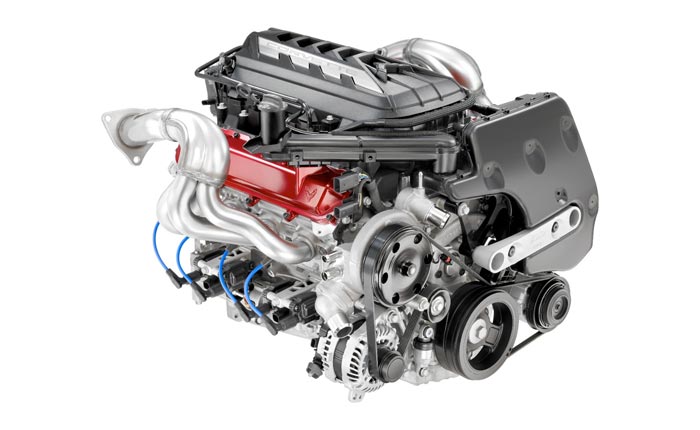It was just Monday that Motor Trend posted the dyno results that broke the internet. The magazine put the 2020 Corvette Stingray on a Mustang dyno to see what kind of power the car is making. The results were beyond surprising: 558 hp and 515 lb-ft of torque at the wheels which equates to 650 hp at the crank.
Immediately we started hearing “how could this be” from a 6.2L V8 engine that was SAE certified at 495 hp and 470 lb-ft of torque. Thankfully, freelance automotive writer Jason Cammisa who wrote the 2020 Corvette Stingray review for Road & Track stepped up to the plate and utilizes math and science to “invalidate a scientific test” in a take-down article on motor1.com.
We call it a take-down because Motor Trend should have known better. Jason believes the dyno operator made a mistake, and then Motor Trend compounded that by publishing the results “at face value”.
Jason says there are two reasons these dyno numbers were incorrect as Motor Trend’s own driving tests delivered the kind of performance numbers expected from a car with the 495-hp and 470 lb-ft of torque, and that it’s impossible for the 6.2L naturally aspirated engine to deliver the 650 hp and 600+ lb-ft of torque.
Utilizing Motor Trend’s own 0-150 MPH tests with the 2020 Stingray, Jason shows the same data from the Road and Track tests as well as a simulator model based on a number of data points from the C7’s LT1. Jason explains why he used the LT1 in his simulation, but the point is all three generate similar performance from 0-150 mph and the quarter-mile times are nearly equal with the times being 11.1 @ 123 mph from Motor Trend vs 11.2 @ 122 mph for the Road & Track test and Jason’s simulator.
Jason says that by changing his data in the simulator to match that of Motor Trend’s dyno numbers (558 hp and 515 lb-ft torque), the real-world quarter-mile results should be 10.3 seconds at 134 mph.

Another confirmation comes from reviewing the Brake Mean Effective Pressure (BMEP) which is a measure of torque per unit displacement. Showing the examples of what the BMEP is for several naturally-aspirated engines, we see that the Corvette displacement of 6,162 cc (6.2L) and 470- lb-ft of torque should have a BMEP of 13.0 bar, but by plugging in Motor Trend’s highest torque figure of 640 lb-ft would elevate the Corvette’s peak BMEP to 17.7 bar which Jason says is impossible for a naturally-aspirated engine.
Motor1.com asked General Motors to comment about the dyno controversy and their reply is below:
“We have spoken with Motor Trend about its dyno testing of the 2020 Corvette Stingray. We cannot be sure what procedures were followed during its testing, as we were not present during nor informed about the dyno test until after it was performed. The vehicle we provided was completely representative of the cars we will be providing to customers. GM follows a strict protocol on certifying engine power ratings, and we stand by our Society of Automotive Engineers’ certification of the output of the Stingray’s LT2 engine.”
Even though we would love to believe that GM under promised and over delivered with the LT2 V8, it’s just not scientifically feasible for the naturally aspirated engine to put out kind of performance values that were quoted in the Motor Trend dyno test.
It’s a facinating read with tables and data to back up his points. Make sure you head over to Motor1.com to read the entire article by Jason Cammisa!
Source:
motor1.com
Related:
Motor Trend Dynos the 2020 Corvette Stingray and Finds It Produces More Power than Advertised
The 2020 Corvette Stingray Takes Down the 2020 Porsche 911 Carrera S in First Comparison Test
[VIDEO] Matt Farah’s ‘One Take’ Track Test of the 2020 Corvette Stingray Z51 Coupe
-


![[VIDEO] 2024 Corvette E-Ray Bullies a Nissan GTR and a Lamborghini Aventador SV at the Drag Strip [VIDEO] 2024 Corvette E-Ray Bullies a Nissan GTR and a Lamborghini Aventador SV](https://www.corvetteblogger.com/images/content/uploads/2024/04/041824_3-218x150.jpg)
![[VIDEO] More Quarter Mile Action with the All New 2024 Corvette E-Ray [VIDEO] More Quarter Mile Action with the All New 2024 Corvette E-Ray](https://www.corvetteblogger.com/images/content/uploads/2024/04/041824_2b-218x150.jpg)

I read this yesterday. It is exactly the kind of nerdy, in-depth content that I live for. Be sure to check it everyone!
There is an extra level of intrigue here too as Cammisa used to work for Motor Trend!
Like a moth to a flame….
The Christmas Pony.
Yes, this was a great review of the dyno test. I noticed that the HP and torque values were the same with and without the correction factor.
Yup…Too many were too quick to accuse Chevy of fraud.
NOTHING TO SEE HERE, MOVE ALONG.
More fake news to promote the rag!
And these are the same geniuses that pick “Car/Truck of the Year” award winners?!?!?!? Just more Millennial-driven Fake News.
If the dyno operator made a mistake that bad, he needs to find a new job.
Detroit realist/Mako: +1
I would just like to see the actual calculations the people at M.T. (or whoever) used to derive this “calculated” horsepower. You can actually measure torque, engine RPM and wheel speed on the dyno – no magic or strings and mirrors!
I would have thought that someone at M.T. would have questioned this before making such a claim – but reporters are like salesmen & marketing people – LIZARDS. This type of error could result in deserved challenges to M.T.’s testing of all vehicles – past and present! Motor Trend, Car and Driver, Road and Track are my “GO TO” car mags. This should be a warning to all – do not act like the “sensationalist” newspaper rags!
NOTE: The comment above IS NOT from Gerald Harings, but from Bruce Melton , rbmeltonjr @yahoo.com.
Gerald’s info was on the next section on my screen, which contained his email info and did not appear until I hit RETURN!”. I apologize to Gerald and the readers of this forum.
Robley B. (Bruce) Melton, Jr.
email: [email protected]
Motor Trend just went to my “WENT TO” list with their FAKE NEWS for $$$ stunt.
Comments are closed.